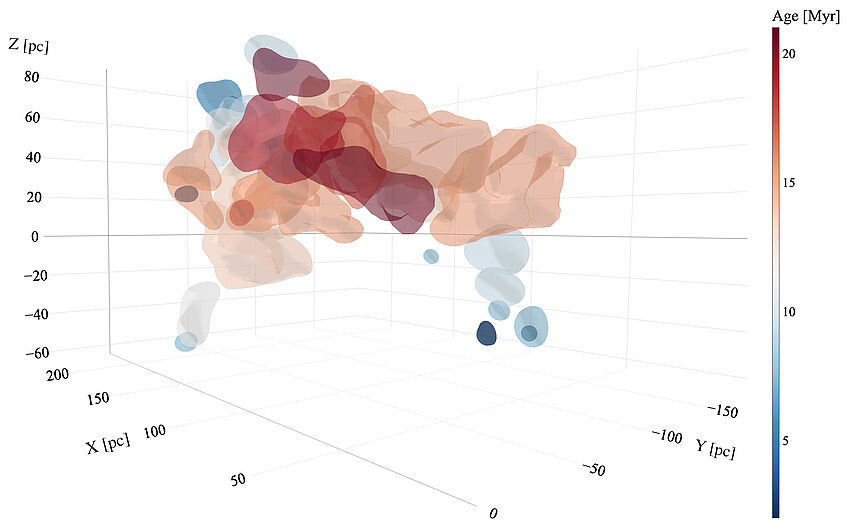The formation history of Sco-Cen revealed by cluster ages
The star formation history of the Sco-Cen association. Coherent star formation patterns in space and time
(Ratzenböck, Großschedl et al. 2023b)
The new clustered view of Sco-Cen produced with SigMA (Ratzenböck, Großschedl et al. 2023a) enabled us to unravel the formation history of this nearby complex by investigating the cluster ages, published in Ratzenböck, Großschedl et al. (2023b)
We estimate the ages via isochrone fitting on CMD sequences (color-magnitude diagrams using Gaia photometry). To this end we apply a Bayesian fitting technique combined with careful selection of the prior distribution based on empirical know-how. We use two different sets of model isochrones (PARSEC Bressan et al. 2012, and Baraffe et al. 2015), which allowed additionally to discuss the feasibility of the various models found in the literature.
The determination of the cluster ages in Sco-Cen led to an improved interpretation of its star formation history. We find spatial-temporal patterns in Sco-Cen (see Fig. 3 and 3D-vis-SCAges). The age patterns indicate an inside-out propagated star formation scenario (supporting Elmegreen & Lada 1977).
Additionally, we find that stars did not form continuously throughout the lifetime of the complex, which has an age of roughly 20 Myr. We identify four "peaks" of star formation, while the star formation rate (SFR) was highest about 15 Myr ago (see Fig. 3). The two more recent star formation events (about 5 and 10 Myr ago) were likely influenced by feedback from massive stars that originated from the massive clusters from the 20-Myr and 15-Myr events. Such feedback was likely able to "push" the remaining gas outwards, creating the inside-out age patterns.
The methodology part was led by Sebastian Ratzenböck (FFG Project FO999892674), who calculated the cluster ages and the age distribution over time. The careful analysis of the cluster ages, including the comparison to earlier studies, the interpretation of the results, and the writing of the discussion sections was led by Josefa Großschedl and João Alves.

Fig. 3. 3D view of the cluster distribution in Sco-Cen in Heliocentric Galactic Cartesian coordinates (XYZ). Figure by Ratzenböck, Großschedl et al. (2023b). The distribution of the clusters is shown with smoothed cluster-surfaces, which are color-coded by age (red = older, blue = younger). We find that the older populations are found at central regions in the association and the younger ones at the outskirts, extending along "arms" below the Galactic Plane. This indicates an inside-out, propagated star formation scenario, where massive stars from the older clusters at the center have influenced the formation of the younger populations. See also the interactive figure: 3D-vis-SCAges.
